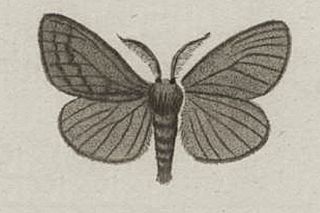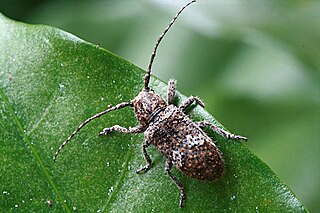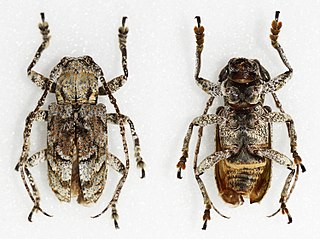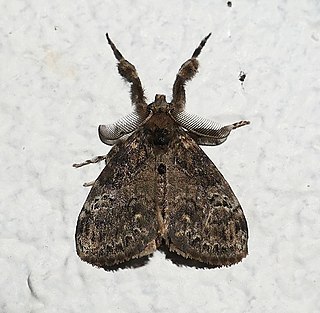
Catocala nymphagoga, the oak yellow underwing, is a moth of the family Erebidae. It is found in Southern Europe, from Bulgaria up to the Iberian Peninsula and sometimes further north as a migrant. It is also found in North Africa and Asia Minor.

Selania is a genus of moths belonging to the subfamily Olethreutinae of the family Tortricidae.
Acontia detrita is a moth of the family Noctuidae. It is found in New South Wales and Queensland.

Ocneria detrita is a moth of the subfamily Lymantriinae. The species was first described by Eugenius Johann Christoph Esper in 1785. It is found in France, Italy and parts of central, south-east and eastern Europe.
Catocala detrita is a moth in the family Erebidae first described by Warren in 1913. It is found in the Ural Mountains of Russia.

Rhytiphora is a genus of flat-faced longhorn beetles in the Pteropliini tribe of the subfamily Lamiinae. The genus was first described in 1835 by Jean Guillaume Audinet-Serville.
Conizonia is a genus of longhorn beetles of the subfamily Lamiinae, containing the following species:

Rhytiphora bankii is a species of beetle in the family Cerambycidae. It was first described by Johan Christian Fabricius in 1775, under the genus Lamia. It is known from Australia, the Philippines, Borneo, Java, Micronesia, New Guinea, Hawaii, Moluccas, Sumatra, Vietnam, and has been introduced into Japan. The Australian species of Prosoplus were synonymised with Rhytiphora in 2013.
Rhytiphora viridescens is a species of beetle in the family Cerambycidae. It was described by Stephan von Breuning in 1938. It is known from Australia.
Rhytiphora ursus is a species of beetle in the family Cerambycidae. It was described by Stephan von Breuning in 1938.
Rhytiphora vestigialis is a species of beetle in the family Cerambycidae. It was described by Francis Polkinghorne Pascoe in 1864. It is known from Australia.
Rhytiphora cinnamomea is a species of beetle in the family Cerambycidae. It was described by Francis Polkinghorne Pascoe in 1859. It is known from Australia.

Rhytiphora maculicornis is a species of beetle in the family Cerambycidae. It was described by Francis Polkinghorne Pascoe in 1858. It is from Australia.
Rhytiphora saundersi is a species of beetle in the family Cerambycidae. It was described by Francis Polkinghorne Pascoe in 1857. It is known from Australia. It contains the varietas Rhytiphora saundersi var. spenceri.
Rhytiphora argus is a species of beetle in the family Cerambycidae. It was described by Francis Polkinghorne Pascoe in 1867. It is known from Australia.
Rhytiphora sospitalis is a species of beetle in the family Cerambycidae. It was described by Francis Polkinghorne Pascoe in 1865. It is known from Australia.
Rhytiphora albocincta is a species of beetle in the family Cerambycidae. It was described by Félix Édouard Guérin-Méneville in 1831, originally under the genus Saperda. It is known from Australia. It feeds on Acacia pubescens and Acacia longifolia. It contains the variety Rhytiphora albocincta var. compos.
Conizonia detrita is a species of beetle in the family Cerambycidae. It was described by Johan Christian Fabricius in 1793, originally under the genus Saperda. It is known from Morocco, Algeria, and Tunisia. It feeds on Scolymus hispanicus. It contains the varietas Conizonia detrita var. maculosa.
Cyana detrita is a moth of the family Erebidae first described by Francis Walker in 1854. The male has a wingspan of 15 mm and the female's is 19 mm.

Orgyia detrita, the fir tussock moth or live oak tussock moth, is a tussock moth in the family Erebidae. The species was first described by Félix Édouard Guérin-Méneville in 1831. It is found in North America.






